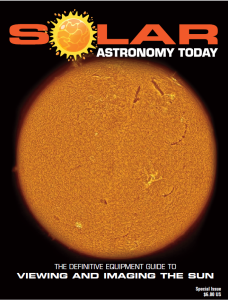Rigel Systems Unobtainium Adapters are, as they note, “Our selection of hard-to-find telescope adapters.” Unobtainium is jargon for a type of material or substance that would be perfect for specific purposes, if it only existed.

While Rigel Systems is perhaps best known for their nFOCUS motor focus controller, wifi-nFOCUS focuser controllers, usb-nFRAME camera/imager rotator/framer, they also now offer Unobtainium Adapters which provide a selection of hard-to-find telescope adapters, such as the 3.28 x 16 tpi to m63 female thread adapter (shown in Image 1) for the larger Celestron and Meade SCTs.
This adapter threads nicely onto the back of the Celestron EdgeHD 9.25, C11, C14 and Meade larger scopes with 3.25 x 16 threads. The adapter provides M63 inside threads to support a wide range of imaging devices such as image rotators and other imaging equipment with M63 male threads.
They also offer an M63 outside to M54/m48 inside thread adapter. As Leon Palmer, owner of Rigel Systems notes, “M63 adapters to other sizes are hard to fine. Believe me I’ve spent hours searching for them! Ours, paired with the “3.28 x 16 tpi adapter, supports the more common m54 & m48 adapters and imaging devices (off axis guiders, filter wheels, cameras). And if you have other devices that need M63 to M54 or M48 conversion, this adapter might be the one for you.
You can learn more about the Rigel Systems Unobtainium Adapters here.

 And to make it easier for you to get the most extensive news, articles and reviews that are only available in the magazine pages of Astronomy Technology Today, we are offering a 1-year magazine subscription for only $6! Or, for an even better deal, we are offering 2 years for only $9. Click here to get these deals which only will be available for a very limited time. You can also check out a free sample issue here.
And to make it easier for you to get the most extensive news, articles and reviews that are only available in the magazine pages of Astronomy Technology Today, we are offering a 1-year magazine subscription for only $6! Or, for an even better deal, we are offering 2 years for only $9. Click here to get these deals which only will be available for a very limited time. You can also check out a free sample issue here.
The sun is more active than it has been in years! If you’d like to learn more the technology behind solar observing, solar imaging and more, you can check out our free publication, “The Definitive Guide to Viewing and Imaging the Sun”. You don’t have to sign up or provide any information, simply click here and enjoy reading!

